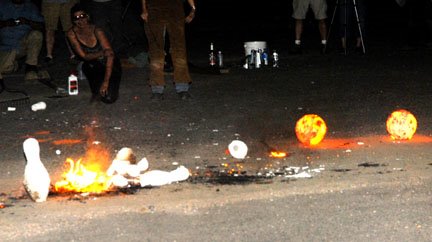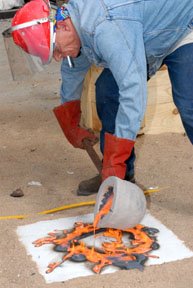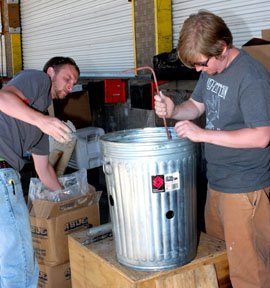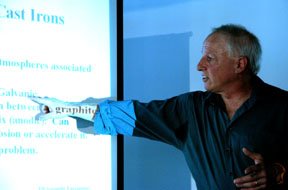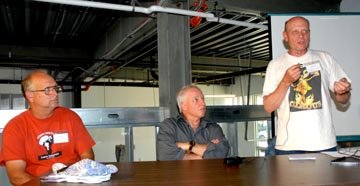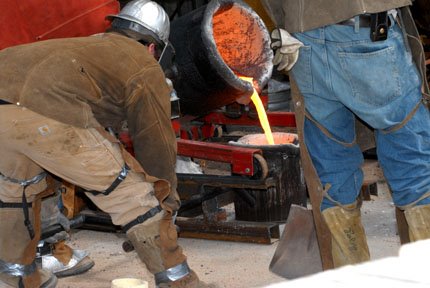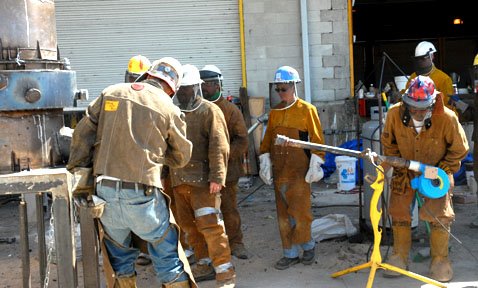Update to now
Last entry was from
Wiseman is a long established northern most outpost for the gold rush, the place where the first air travel in
We arrived on Thursday evening, the eight of us: Donnie, Kristi, Forrest, Barbra, Joe, Mandy, Rhonda Mc Nally (who met us in
Friday morning we unloaded the trucks and began setting up the furnace, etc. Just at the opportune moment Pat Garley, Shane Morgan (from
Saturday morning we started by unloading molds and charges. We had made the molds in
Next time we went to three full charges of 25 pounds each. And we got lots of very hot metal. Several molds got poured. That seemed to be the answer. BUT, when we tried the same regime the next time we got NOTHING, no metal and the tap hole was frozen.
At that point we had the choice of shutting down or trying to clear the cupolette. We dumped the entire thing, all coke, whatever metal, etc. And started again from new bed coke & back burning to ensure that we had a hot well. Again we got hot metal, more molds got poured; BUT the next time we had a well full of slag and no metal. We decided to call it off and dumped every thing once more. We never did get metal again.
We did cast a plaque, the “cap piece”, the base & one section to the obelisk, plus several of the molds that had come up from Pat’s molding workshop. In retrospect, its obvious that I had made the well too deep and the metal was cooling before the third charge was melted. So much for calculations versus experience. I SHOULD have taken the measurements from the furnace that worked in NYC and raised the slagger and tuyere an inch or so to give us the 50 pounds we needed. But I had recalculated and went with those measurements.
As Pat said, it wasn’t a runaway success, nor was it an unqualified failure. Somewhere in between. The plaque, which poured slightly “short”, but OK, is now installed next to the flag pole at the Wiseman Community center, the base, cap, and section, and other section molds are on their way to Palmer to be finished out and/or poured at the Wasilla pour next Saturday, or, God forbid, at Kenai the Friday after. The entire project will be complete sometime between now and next August.
We cleaned the site on Sunday, after the Saturday pour. Its pretty much the same as when we arrived, except there is a lightly used cupolette sitting next to the 55 gallon, burn barrel and a few chunks of mold waste that will be carved into molds before next year’s Wasilla pour.
But, as far as the residents of Wiseman were concerned, it was a smashing success. When we stopped at the Visitor’s Center and cafe in Cold Foot this Monday morning to get our “certificates” that verify that we have crossed the arctic circle, everyone was happy and still excited. It had been exhilarating for them to have us come and even attempt to pour iron, and the plaque was just gravy after the fact.
And, Oh yeah, I forgot to mention that mid-pour we got about twenty minutes of rain and that the mosquitoes were vicious. Kristin, one of the ladies who invited us to Wiseman, always had a lit mosquito coil in her hand as she walked around. We had to make do with the Off that we brought.
Further Update to Now, Now Having Changed
The current NOW is in Palmer,
The big draw is, of course,
Preparations for the Wasilla Pour are underway. Scott Hamann had delivered the furnace that Pat designed and we burned it in, twice. With a couple of minor modifications it looks ready to run and should tap out between 120-200 pounds, depending.
We have fabricated two ladles, one standard refractory lined and one that D’Jean made with fiber lining, plus we still have two of our smaller fiber ladles as backup, just in case. We still have to make some cupola tools and finish up molds.
Further down the new Now.
The Wasilla pour is history, we haven’t cleaned up the site yet, but its done. Most importantly, it went very well. Lots of good hot iron. The new cupolette tapped 220 pounds, or would have if we’d had a ladle big enough; we had to bott mid-stream and the crew didn’t like a heavy ladle, so we took three taps per set of charges. All the molds poured, only one had any mis-casting, & I suspect that the core was too thick at that point, or it shifted in transit.
The piece for Wiseman is all cast and ready to be finished at leisure. The Wasilla plaque is ready to clean and install. And the
The public information has been spotty and somewhat inaccurate, but great fun. In the local Palmer newspaper D’Jean Jawrunner is the “featured” artist because she is a known quantity here. Pat, Donnie, & I have given her a hard time about it, mostly Pat who is local and can’t get much of a mention in his home town. They have known each other for so long now its difficult to know who did what first, but D'Jean is the "teacher of record". My father always used to say that “a prophet’s mouth is always ‘stopped’ in his own land”, it seems to still be true. We shall see what the Anchorage paper has to say in its Wednesday section.
Pictures and extensive info to follow. Internet access is mostly not easily available, sorry.
Butch










